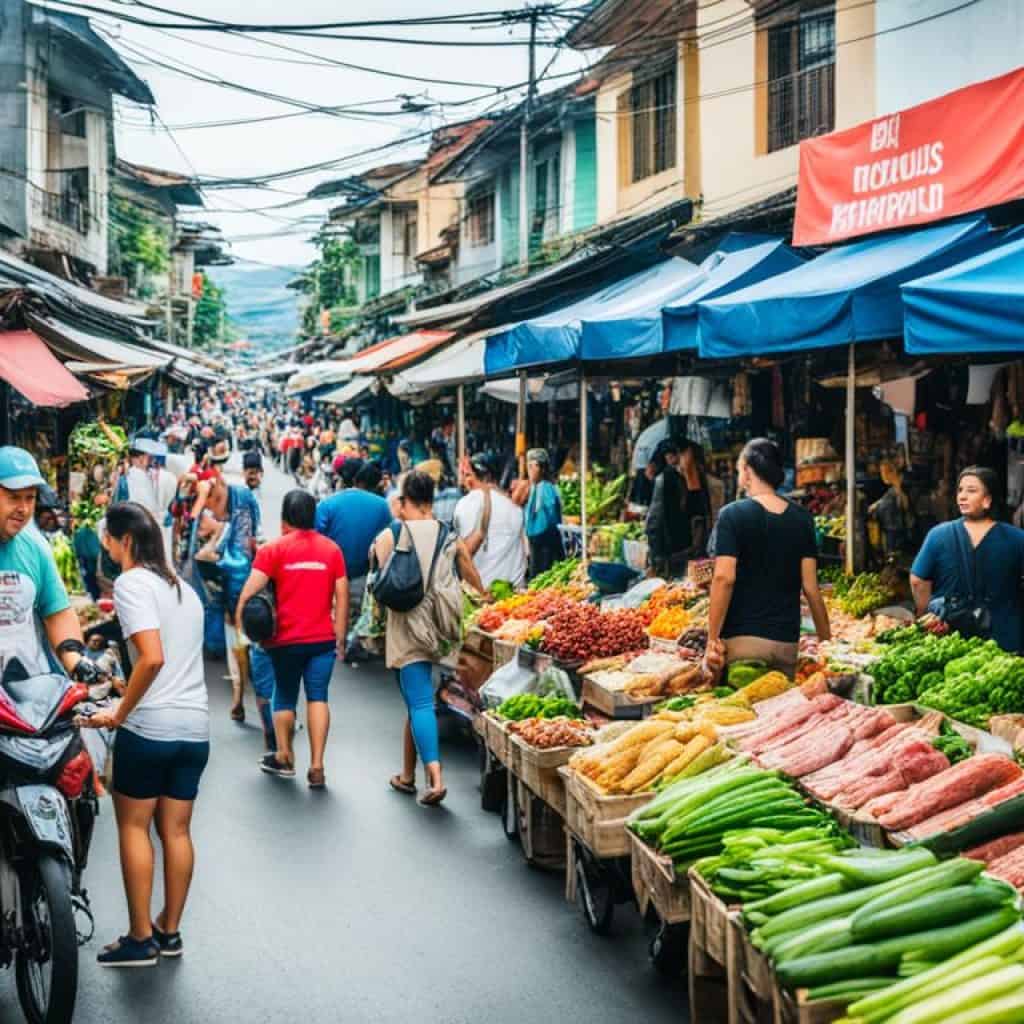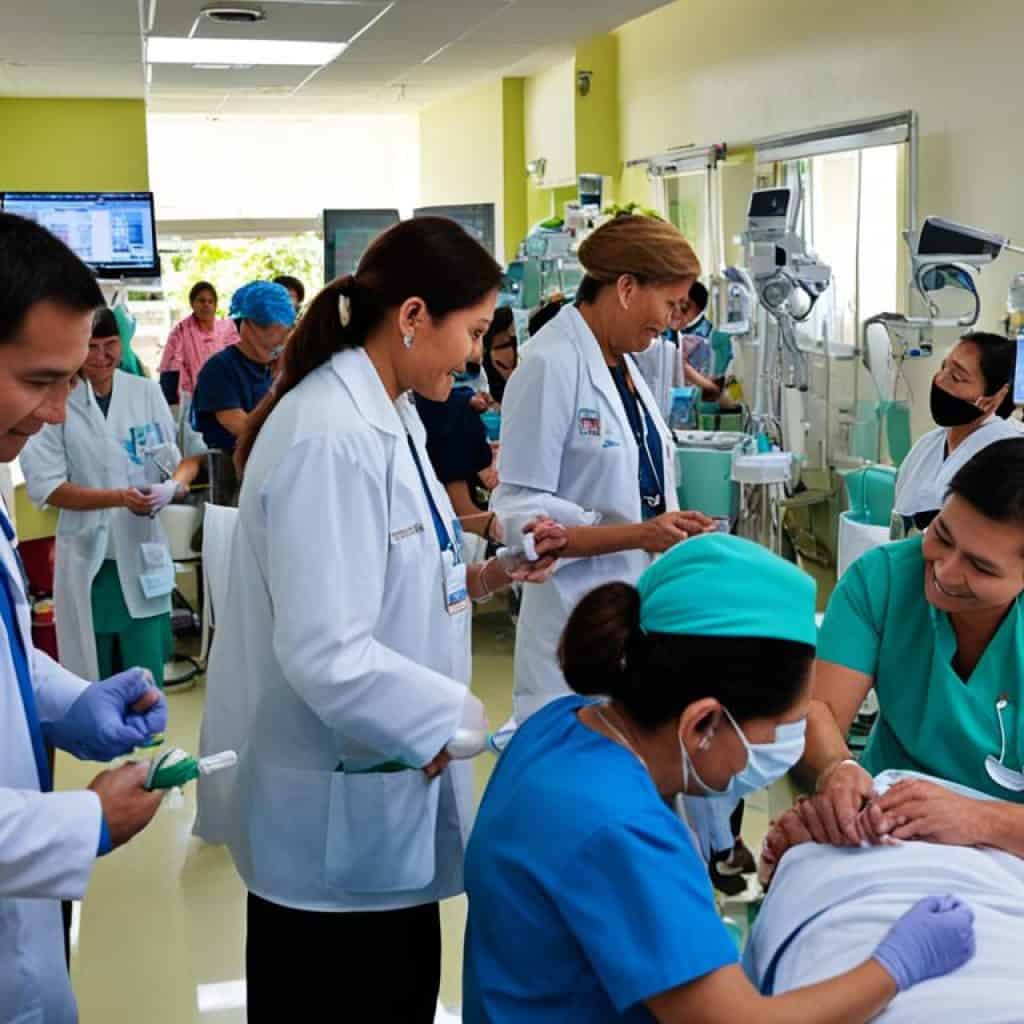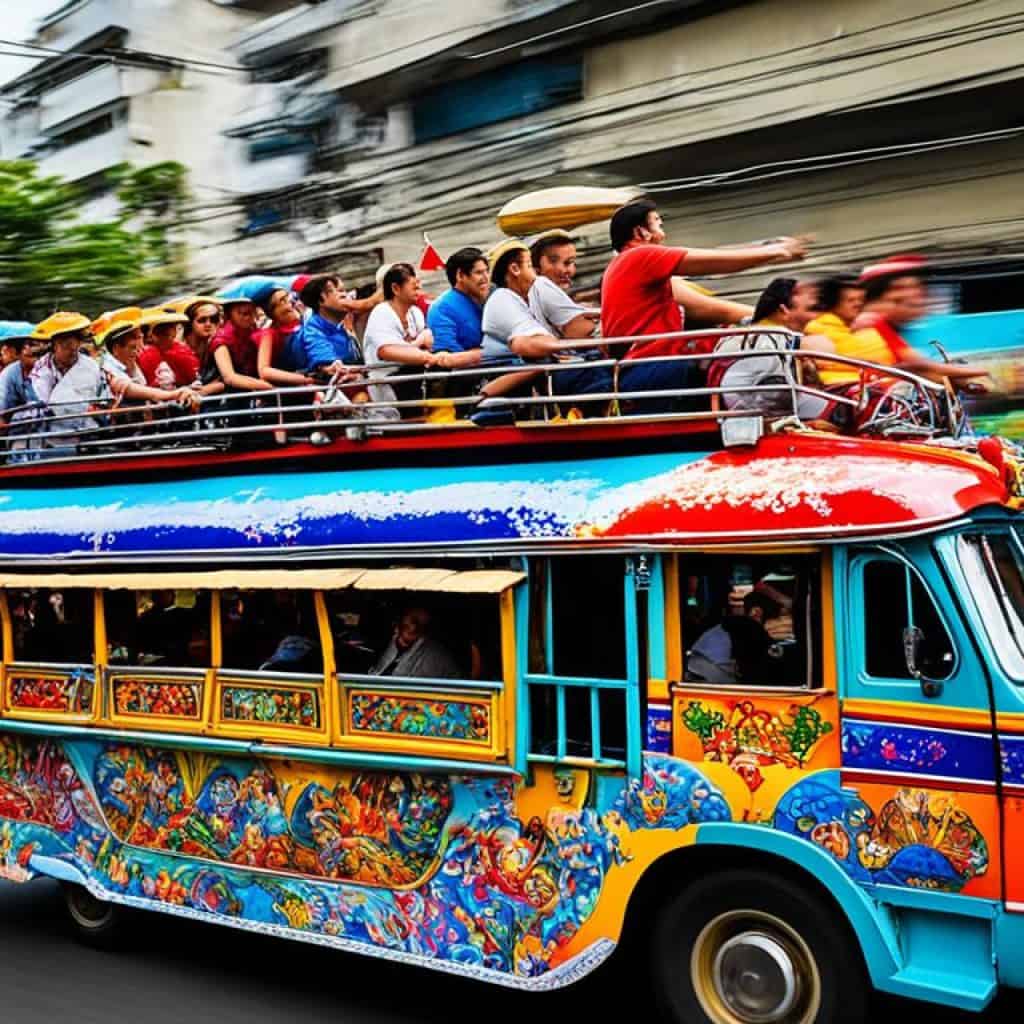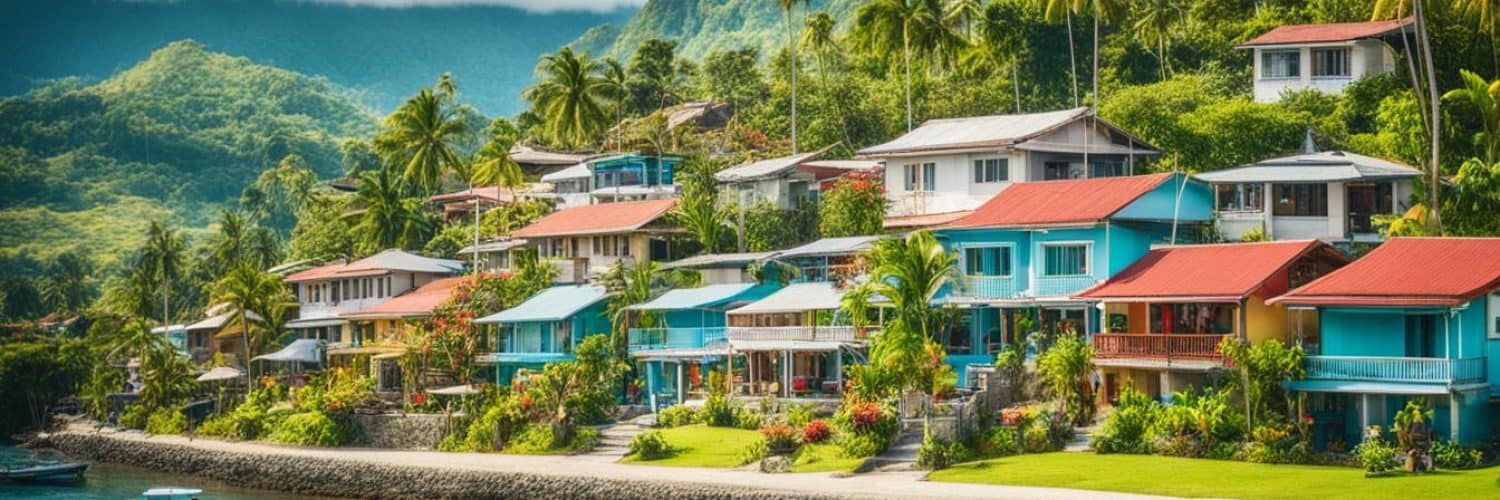Have you ever wondered what it would be like to live in a country where stunning beaches, vibrant festivals, and warm hospitality are part of everyday life? Welcome to the Philippines, a country that offers all of this and more. Whether you’re considering a move as an expat, planning a travel adventure, or simply curious about Filipino culture and lifestyle, this article will guide you through the ins and outs of life in the Philippines in 2023.
From the cost of living to the best places to live, we’ll provide you with valuable insights and practical tips to help you make the most of your experience in the Philippines. Discover the vibrant local culture, explore breathtaking natural wonders, and immerse yourself in the friendly Filipino way of life. Are you ready to explore the Philippines in all its glory?
Key Takeaways:
- Learn about the cost of living in the Philippines and how it compares to other countries.
- Discover the visa options available for Americans looking to move to the Philippines.
- Understand the healthcare system and the importance of health insurance in the Philippines.
- Explore the housing options and find out the average prices for rent and property.
- Get tips on transportation, banking, education, and more to make your life in the Philippines seamless and enjoyable.
Basic Facts about the Philippines
As you explore the Philippines, it’s essential to familiarize yourself with some basic facts about this captivating country. From its rich culture and diverse languages to its vibrant population and unique government system, the Philippines offers a truly one-of-a-kind experience. Here are some key details to get you started:
- Filipino Culture: The Philippines is renowned for its vibrant and diverse culture, influenced by various indigenous, Spanish, and American traditions.
- Languages in the Philippines: The two official languages in the Philippines are Filipino (based on Tagalog) and English. These languages are widely spoken and understood throughout the country.
- Filipino Population: With an approximate population of 117 million people, the Philippines is a bustling nation filled with warm and friendly locals.
- Currency in the Philippines: The official currency of the Philippines is the Philippine peso (PHP). It’s advisable to familiarize yourself with currency exchange rates and carry cash or use cards widely accepted in the country.
- Filipino Government: The Philippines operates under a democratic and presidential representative federal republic system. The government is structured with three branches: executive, legislative, and judicial.
- Religion in the Philippines: The majority of Filipinos practice Christianity. The country has been predominantly Catholic since the Spanish colonization era, with many other Christian denominations also present.
These basic facts lay the foundation for understanding the diverse and captivating aspects of life in the Philippines. As we delve deeper into the various aspects of living and experiencing this enchanting country, you’ll gain a comprehensive insight into what awaits you in the Philippines.
Moving to the Philippines as an American
If you’ve been dreaming of a new adventure and considering moving to the Philippines, you’re not alone. The Philippines offers a welcoming environment, stunning natural beauty, and a unique cultural experience that attracts many US citizens. In this section, we will explore the steps and options for Americans looking to make the Philippines their long-term home.
Visa Options for US Citizens
As a US citizen, you have several visa options available to facilitate your move to the Philippines. Whether you plan to work, study, retire, join family, or spouse, there is a visa category that suits your needs. Here are the most common visa types:
- Work Visa: If you plan to work in the Philippines, you will need to apply for a work visa. This requires sponsorship from a Philippine employer and meeting specific criteria.
- Student Visa: If you’re pursuing higher education in the Philippines, a student visa is required. This visa allows you to study at accredited educational institutions.
- Retirement Visa: The Philippines offers a retirement visa program, which allows US citizens who meet the age and financial requirements to retire and live in the country.
- Joining Family or Spouse Visa: If you have immediate family members who are Philippine citizens or legal residents, you can apply for a visa to join them.
Each visa type has its own set of requirements, including documentation and fees. It is essential to consult with the Philippine Embassy or Consulate in your area to get the most up-to-date information and guidance on the visa application process.
“The Philippines warmly welcomes Americans who wish to immerse themselves in our beautiful country. We offer a range of visa options designed to meet various needs, enabling you to make the Philippines your home. We encourage you to explore these opportunities and experience our unique culture, vibrant traditions, and breathtaking landscapes.” – Philippine Embassy
| Visa Type | Requirements | Fees |
|---|---|---|
| Work Visa | Employment contract, valid passport, medical examination, police clearance, proof of financial capability, and other documents as required by the Philippine Bureau of Immigration. | Approximately $100-$200, depending on the duration and type of work visa. |
| Student Visa | Letter of acceptance from an accredited educational institution, valid passport, medical examination, proof of financial capability, and other documents as required by the Philippine Bureau of Immigration. | Approximately $60-$140, depending on the length of the student visa. |
| Retirement Visa | Proof of retirement and monthly pension, valid passport, medical examination, proof of financial capability, and other documents as required by the Philippine Bureau of Immigration. | Approximately $140-$360, depending on the type and duration of the retirement visa. |
| Joining Family or Spouse Visa | Proof of relationship, valid passport, medical examination, letter of invitation or sponsor, proof of financial capability, and other documents as required by the Philippine Bureau of Immigration. | Approximately $60-$120, depending on the type and duration of the visa. |
Once you have obtained the appropriate visa, you will be well on your way to enjoying the beauty and warmth of the Philippines as a long-term resident.
Cost of Living in the Philippines
When considering a move to the Philippines, understanding the cost of living is essential for planning your budget. Compared to the United States, the cost of living in the Philippines is remarkably affordable, making it an attractive destination for expats seeking a lower cost of living without compromising on quality of life.
How Does the Cost of Living Compare?
On average, the cost of living in the Philippines is approximately 52% cheaper than in the United States. This means that your living expenses, such as meals, groceries, transportation, utilities, and housing, will likely be significantly more affordable, allowing you to stretch your budget further.
Examples of Everyday Expenses
To give you a better idea of the cost of living in the Philippines, let’s take a look at some everyday expenses:
| Expense | Cost in the Philippines | Cost in the US |
|---|---|---|
| Meal at an inexpensive restaurant | $3 – $5 | $12 – $15 |
| Loaf of bread | $0.50 – $1 | $2 – $3 |
| Domestic beer (0.5L) | $1 – $2 | $5 – $7 |
| Public transport fare | $0.20 – $0.50 | $2 – $3 |
| Utilities (electricity, water, gas) | $50 – $100 | $100 – $150 |
| Rent (1-bedroom apartment in city center) | $200 – $400 | $1,500 – $2,500 |
| Property prices (per square meter) | $1,000 – $2,500 | $7,000 – $13,000 |

Affordable Living in the Philippines
With the significantly lower cost of living, the Philippines offers opportunities for affordable living that can enhance your quality of life. Whether you dream of enjoying beachside living or prefer the bustling city life, you’ll find affordable housing options that suit your preferences and budget.
If you’re looking for a more budget-friendly lifestyle without sacrificing comfort and convenience, the Philippines is a perfect choice. Stretch your dollar further, embrace a relaxed and vibrant culture, and make the most of your life in this tropical paradise.
Immigration and Visas
Are you considering a move to the Philippines? Understanding the immigration and visa requirements is crucial for a smooth transition to your new life. Whether you’re planning to work, study, or retire in the Philippines, there are specific visa options available for US citizens. Let’s explore some of the key visa types you need to know.
1. Work Visa in the Philippines
If you’re looking to work in the Philippines, you’ll need to obtain a work visa. The most common work visa is the 9(g) Pre-arranged Employment Visa, which requires sponsorship from an employer in the Philippines. The requirements for this visa include a job offer, a valid employment contract, and proper documentation.
2. Student Visa in the Philippines
For US students planning to study in the Philippines, a student visa is necessary. The 9(f) Student Visa allows you to enroll in an educational institution in the country. To obtain this visa, you’ll need an acceptance letter from a recognized educational institution, proof of financial capability, and a valid passport.
3. Retirement Visa in the Philippines
If you’re dreaming of retiring in the Philippines, the Special Resident Retiree’s Visa (SRRV) is your pathway. This visa offers benefits such as multiple-entry privileges, exemption from Philippine Bureau of Immigration fees, and the option to work or invest in the country. To qualify for the SRRV, you need to be at least 35 years old, have a pension of at least $800 per month, and meet other financial requirements.
Visa Requirements and Fees
It’s important to familiarize yourself with the specific requirements and fees associated with each visa type. The requirements may include passport validity, medical examinations, police clearances, and application fees. Make sure to consult the Philippine Embassy or consulate in your area for the most up-to-date information on visa requirements and fees.
Image:
Understanding the immigration and visa process is essential when planning your move to the Philippines. Whether you’re pursuing job opportunities, furthering your education, or enjoying your retirement, there is a visa option that suits your needs. Ensure that you fulfill the specific requirements for each visa type and prepare the necessary documentation for a smooth immigration process. Consult the Philippine Embassy or consulate for detailed information on visa requirements and procedures.
Housing in the Philippines
When it comes to finding a place to live in the Philippines, you have various housing options to consider. Whether you are looking to rent or buy property, the country offers a range of choices to suit different budgets and preferences.
If you are planning to rent, the average cost of rent in the Philippines can vary depending on the location. In major cities like Manila and Cebu, rental prices may be higher compared to smaller towns or rural areas. It’s important to research and compare rental prices in different neighborhoods to find the best option for you.
On the other hand, if you are interested in buying property in the Philippines, it’s worth noting that foreigners generally cannot own land, except in certain circumstances. However, there are options available, such as purchasing a condominium unit or partnering with a Filipino citizen to acquire property. Property prices can also vary greatly depending on the location and type of property.
Considerations for finding accommodation in the Philippines include proximity to amenities, transportation options, and safety. It’s advisable to visit the area in person and explore the neighborhood before making a decision. Additionally, working with a local real estate agent can provide valuable insights and guidance throughout the process.
Healthcare in the Philippines
When it comes to healthcare in the Philippines, there are options available through the public and private sectors. The public healthcare system is administered by PhilHealth, a government-owned corporation that provides health insurance coverage to Filipinos. Public healthcare in the Philippines offers affordable medical services and access to a network of government hospitals and clinics throughout the country.
However, it is important to note that public healthcare in the Philippines may have limitations in terms of resources and facilities. As a result, some individuals, especially expats and those with specific medical needs, opt for private healthcare in the Philippines. Private hospitals in major cities like Manila offer advanced medical treatments, state-of-the-art facilities, and personalized care, but they come at a higher cost.
For expats moving to the Philippines, having health insurance is crucial. Health insurance provides financial protection and access to private healthcare services. It ensures that you receive the necessary medical care without worrying about high expenses. Insurance options catered specifically to expats are available, offering comprehensive coverage for various medical procedures and emergencies.

Comparison of Public and Private Healthcare in the Philippines
| Aspect | Public Healthcare | Private Healthcare |
|---|---|---|
| Cost | Affordable, with contributions to PhilHealth | Higher cost, varying based on treatments and facilities |
| Accessibility | Availability of government hospitals and clinics throughout the country | Private hospitals concentrated in major cities |
| Facilities | Varies depending on the specific government healthcare facility | State-of-the-art facilities with advanced medical technology |
| Waiting Times | May experience longer wait times for certain procedures | Shorter waiting times and more personalized services |
| Specializations | Limited specialization options | Wide range of specialized medical services |
It’s important to weigh the advantages and disadvantages of both public and private healthcare in the Philippines based on your specific healthcare needs and budget. Consulting with a healthcare professional or insurance specialist can help you make an informed decision.
Banking and Finances in the Philippines
When it comes to banking and finances in the Philippines, there are a few key things that US citizens should know. Whether you’re planning to open a bank account, access local banking services, or withdraw cash from ATMs, understanding the local system can make managing your finances easier. Here’s what you need to know:
Opening a Bank Account
If you’re a US citizen looking to open a bank account in the Philippines, you’ll find a range of options available. Major local banks such as BDO (Banco de Oro), BPI (Bank of the Philippine Islands), and Metrobank offer a variety of account types to suit your needs. These banks have branches in major cities and provide convenient online banking services as well.
Opening a bank account in the Philippines as a US citizen is relatively straightforward. You’ll typically need to provide valid identification, proof of address, and an initial deposit. The required minimum deposit amount varies between banks, so it’s best to check with the specific bank you plan to open an account with.
Local Banking Services
The Philippines has a well-developed banking system that offers a wide range of financial services. In addition to basic savings and checking accounts, local banks provide services such as loans, credit cards, investments, and remittances. These services are widely available in major cities throughout the country, ensuring convenient access to financial resources.
ATMs and Fees
ATMs are readily available in the Philippines, making it easy to withdraw cash or check your account balance. Major banks have extensive ATM networks, and you’ll find ATMs in popular tourist areas as well. However, it’s important to note that some ATMs may charge fees for withdrawals made by foreign cards. It’s recommended to check with your home bank regarding any associated fees and consider using ATMs affiliated with your bank to minimize additional charges.
Now that you have an understanding of banking and finances in the Philippines, you can confidently manage your money while living or traveling in the country. Whether you’re opening a bank account, accessing local banking services, or using ATMs, knowing the basics will help make your financial transactions more convenient.
| Bank | Number of Branches | Online Banking | ATM Locations |
|---|---|---|---|
| BDO (Banco de Oro) | Over 1,000 | Available | Extensive network |
| BPI (Bank of the Philippine Islands) | Over 800 | Available | Wide coverage |
| Metrobank | Over 900 | Available | Nationwide presence |
Education in the Philippines
Education plays a crucial role in the development and progress of any nation, and the Philippines is no exception. The Filipino education system is a combination of public and private schools, offering a wide range of opportunities for students to excel academically and professionally.
One notable aspect of education in the Philippines is the emphasis on English language proficiency. English is widely spoken and used as the medium of instruction in schools, making it easier for international students to adapt and communicate effectively. This focus on English language skills also provides Filipino students with an advantage in a globalized world.
In addition to public and private schools, the Philippines is home to various international schools in major cities. These schools follow an international curriculum and cater to the diverse needs of expatriate families and foreign students. International schools provide a high standard of education and offer a multicultural learning environment that fosters global perspectives and cultural awareness.
Whether it’s the well-established public and private schools or the international schools, the education system in the Philippines is committed to equipping students with the knowledge, skills, and values they need to succeed in their personal and professional lives.
“Education is the most powerful weapon which you can use to change the world.” – Nelson Mandela
Prominent Features of the Filipino Education System:
- A mix of public and private schools
- Classes taught in English
- Diverse curriculum
- Focus on holistic development
- Incorporation of technology in education
International Schools in the Philippines:
Here are some well-known international schools in the Philippines:
| School Name | Location | Curriculum |
|---|---|---|
| International School Manila | Manila | International Baccalaureate (IB) |
| British School Manila | Taguig City | British Curriculum (IGCSE and A-Level) |
| Cebu International School | Cebu City | International Baccalaureate (IB) |
| Brent International School Manila | Biñan, Laguna | International Baccalaureate (IB) |
| German European School Manila | Mandaluyong City | German Curriculum |
Education in the Philippines is a dynamic and evolving field, committed to fostering the intellectual, emotional, and social growth of its students. Whether you choose a public, private, or international school, you can expect to receive quality education in a supportive and inclusive learning environment.
Getting Around in the Philippines
When it comes to transportation in the Philippines, you’ll find a variety of options to help you navigate this beautiful archipelago. From bustling cities to picturesque islands, here are the top ways to get around:
1. Public Transport
Public transport in the Philippines is reliable, affordable, and a great way to immerse yourself in the local culture. Buses, trains, and jeepneys are popular modes of public transportation that can take you to different parts of the country. Jeepneys, in particular, are a unique symbol of Philippine transportation and offer an authentic experience.
2. Taxis
If you prefer a more convenient and private means of transportation, taxis are readily available in major cities. They are metered and provide a comfortable way to travel short or long distances. Just be sure to check that the taxi has a functioning meter before getting in.
3. Domestic Flights
Considerations for Driving in the Philippines
- Driving in the Philippines can be challenging due to traffic congestion and unfamiliar road conditions. It is advisable to use navigation systems or maps to navigate through cities and countryside areas.
- Ensure you have a valid international driver’s license and familiarize yourself with local traffic rules and regulations.
- Be cautious of motorcyclists, pedestrians, and other road users who may not always adhere to traffic laws.
| Transportation Option | Key Features |
|---|---|
| Public Transport (Jeepneys, Buses, Trains) | Affordable, widely available, and an opportunity to experience local culture |
| Taxis | Convenient, private, and useful for short or long distances within cities |
| Domestic Flights | Quick and efficient for traveling between different islands |

Cost of Moving to the Philippines
Shipping Costs
When it comes to shipping your belongings to the Philippines, there are a few factors that can affect the cost. The size and weight of your shipment, the distance traveled, and the shipping method you choose all play a role in determining the total expenses.
On average, shipping a 20-foot container from the United States to the Philippines can cost around $2,000 to $3,000. This cost can vary depending on the specific details of your move, so it’s essential to get quotes from different shipping companies to find the best deal.
It’s also worth considering additional fees such as customs duties and taxes, which may apply to certain items. Researching and understanding the customs regulations beforehand can help you avoid unexpected costs and delays.
Flights to the Philippines
If you’re moving to the Philippines, you’ll also need to factor in the cost of flights. The prices can vary depending on your departure location, travel dates, and airline preferences.
On average, a one-way ticket from the United States to the Philippines can cost between $500 and $1,500, depending on various factors. Booking in advance and being flexible with your travel dates can help you find the best deals and save on airfare expenses.
Summary of Moving Costs
| Expense | Average Cost |
|---|---|
| Shipping a 20-ft container | $2,000 – $3,000 |
| Flight from the US | $500 – $1,500 |
Keep in mind that these costs are just estimates and can vary depending on individual circumstances. It’s essential to budget accordingly and consider any additional expenses that may arise during the moving process.
Safety and Crime in the Philippines
When considering life in the Philippines, it’s essential to be aware of the safety concerns that may exist. While the majority of visitors and residents have safe and enjoyable experiences, it’s important to remain vigilant and take necessary precautions to ensure personal safety. This section provides an overview of safety in the Philippines, including crime rates and terrorism threats, along with tips for staying safe as a foreigner in this beautiful country.
Crime Rates in the Philippines
As in any country, the Philippines does experience crime rates. While the overall crime rate has decreased in recent years, it’s still important to remain cautious and take necessary safety measures. Theft, pickpocketing, and scams are the most common types of crimes tourists and expats may encounter. Areas with high tourist traffic, such as popular attractions and public transportation hubs, may be more prone to such incidents.
It’s advisable to keep valuables secure, avoid displaying excessive wealth, and be cautious in unfamiliar areas. Additionally, utilizing reliable transportation options and avoiding walking alone at night can contribute to personal safety. By staying alert and maintaining situational awareness, you can minimize the risk of falling victim to crime.
“Safety is a personal responsibility, and staying informed about the potential risks is crucial to protect yourself and your belongings.”
Terrorism Threats in the Philippines
The Philippines has experienced sporadic incidents related to terrorism, particularly in certain regions. Ongoing conflicts between the Philippine government and extremist groups have resulted in isolated incidents of violence, particularly in the southern part of the country.
Tips for Staying Safe in the Philippines
To ensure your safety while in the Philippines, consider the following tips:
- Research and understand the local laws and customs of the Philippines.
- Remain vigilant in crowded places, such as markets and public transportation.
- Avoid displaying excessive wealth or valuable belongings.
- Use reputable transportation services and avoid hailing unmarked taxis or motorcycles.
- Keep important documents, such as passports and identification, in a secure location.
- Stay updated on current events, travel advisories, and any potential security risks.
By applying these precautions, you can enjoy your time in the Philippines while minimizing the potential risks associated with safety and crime.
| Crime Statistics | Safety Measures |
|---|---|
| Theft | Secure your valuables and avoid displaying excessive wealth. |
| Pickpocketing | Stay alert in crowded areas and keep your belongings secure. |
| Scams | Be cautious with unfamiliar individuals and situations. |
| Terrorism | Avoid areas with known conflict or terrorist activity. |
Pros and Cons of Living in the Philippines
Living in the Philippines offers a unique experience with its own set of advantages and disadvantages. It’s essential to consider both the pros and cons before making a decision to move or settle down in this beautiful country.
Advantages of Living in the Philippines:
- Affordability: The cost of living in the Philippines is relatively low compared to many other countries. Housing, food, and transportation expenses are generally more affordable, allowing you to enjoy a comfortable lifestyle within your budget.
- Diverse Public Transportation: The Philippines has a wide range of transportation options, including jeepneys, tricycles, buses, and taxis. This variety makes it convenient to navigate and explore the country, particularly in urban areas.
- Sense of Community: Filipinos are known for their warm hospitality and strong sense of community. You’ll find a welcoming and friendly environment, making it easy to build connections and create lasting friendships.
- Natural Attractions: The Philippines boasts breathtaking natural wonders, from pristine white-sand beaches to lush mountains and vibrant coral reefs. You’ll have ample opportunities to explore and enjoy the country’s stunning landscapes and diverse ecosystems.
Disadvantages of Living in the Philippines:
- Crowded Cities: Some urban areas in the Philippines can be congested and crowded, especially during peak hours. Traffic can be a challenge, requiring patience and careful planning in your daily commute.
- Expensive Electricity: Electricity rates in the Philippines are relatively high compared to neighboring countries. It’s important to budget for utility expenses, especially if you have a large household or rely heavily on air conditioning.
- Crime Rates: While the majority of the Philippines is safe for residents and tourists, like any country, it’s important to be aware of potential safety concerns. Take precautions, stay informed, and adopt common-sense safety practices to minimize risks.
- Risk of Natural Disasters: The Philippines is prone to natural disasters, including typhoons, earthquakes, and volcanic eruptions. It’s essential to understand emergency protocols and remain prepared for such events.
It’s important to weigh these pros and cons based on your individual circumstances, preferences, and priorities. Consider factors such as your financial situation, lifestyle preferences, and personal safety when making a decision about living in the Philippines.
Conclusion
Living in the Philippines offers a unique and vibrant experience for both expats and travelers. The country’s affordable cost of living, diverse culture, and breathtaking natural attractions make it an enticing destination. Many people choose to call the Philippines their home, drawn by its warm hospitality and the opportunity to immerse themselves in the local way of life.
However, it’s important to be aware of the potential challenges that come with living in the Philippines. Crowded cities, high crime rates, and the risk of natural disasters are aspects that require consideration and planning. By being prepared and taking the necessary precautions, you can ensure a safe and rewarding experience in this beautiful country.
Whether you’re seeking adventure, relaxation, or a sense of community, the Philippines has something to offer. From idyllic beach towns to bustling urban centers, there are a variety of places to choose from that suit different lifestyles and preferences. Embrace the vibrant Philippine culture, indulge in the delicious local cuisine, and explore the stunning landscapes that make this country truly special.
In conclusion, living in the Philippines can be a fulfilling and enriching experience. With its unique blend of affordability, cultural diversity, and natural wonders, it’s no wonder why so many people are drawn to this Southeast Asian gem. Just keep in mind the potential challenges and plan accordingly, and you’ll be well on your way to a remarkable life in the Philippines.
FAQ
What are the basic facts about the Philippines?
The Philippines is the capital of Manila and its main languages are Filipino and English. It has a population of approximately 117 million and its currency is the Philippine peso (PHP). The country operates under a democratic and presidential representative federal republic government, and the majority of its population practices Christianity.
Can US citizens legally move to the Philippines for a long-term stay?
How does the cost of living in the Philippines compare to the US?
What are the different visa types available for US citizens in the Philippines?
US citizens in the Philippines can choose from various visa types, including work, student, and retirement visas. Each visa type has its own requirements and fees. There is also a Special Resident Retiree’s Visa (SRRV) specifically designed for foreigners retiring in the Philippines.
What are the housing options in the Philippines?
What is the healthcare system like in the Philippines?
The Philippines has both public and private healthcare options. The public healthcare system is administered by the government-owned PhilHealth, while private healthcare offers a wider range of services but comes at a higher cost. It is important for expats to have health insurance to ensure access to quality healthcare.
Can US citizens open a bank account in the Philippines?
Yes, US citizens can open a bank account in the Philippines. Banking and financial services are available in major cities. There are also ATMs throughout the country, but it’s important to be aware of any associated fees.
What is the education system like in the Philippines?
The education system in the Philippines consists of a mix of public and private schools, with classes primarily taught in English. There are also international schools available in major cities for expat children.
What are the transportation options in the Philippines?
In the Philippines, you have various transportation options, including buses, trains, jeepneys, taxis, and domestic flights. Public transport is generally available and affordable, but there are also considerations for driving in the Philippines.
What expenses should I consider when moving to the Philippines?
When moving to the Philippines, you should consider expenses such as shipping costs and flights. The average costs of shipping containers from the US to the Philippines can vary, so it’s important to plan your budget accordingly.
What are the safety concerns in the Philippines?
The Philippines has some safety concerns, including crime rates and potential terrorism threats. It’s important to be aware of your surroundings and take precautions to stay safe as a foreigner in the country.
What are the pros and cons of living in the Philippines?
Living in the Philippines has its advantages and disadvantages. Some pros include affordability, diverse public transportation, a sense of community, and stunning natural attractions. However, there are also cons to consider, such as crowded cities, expensive electricity, high crime rates, and the risk of natural disasters.


















Add comment